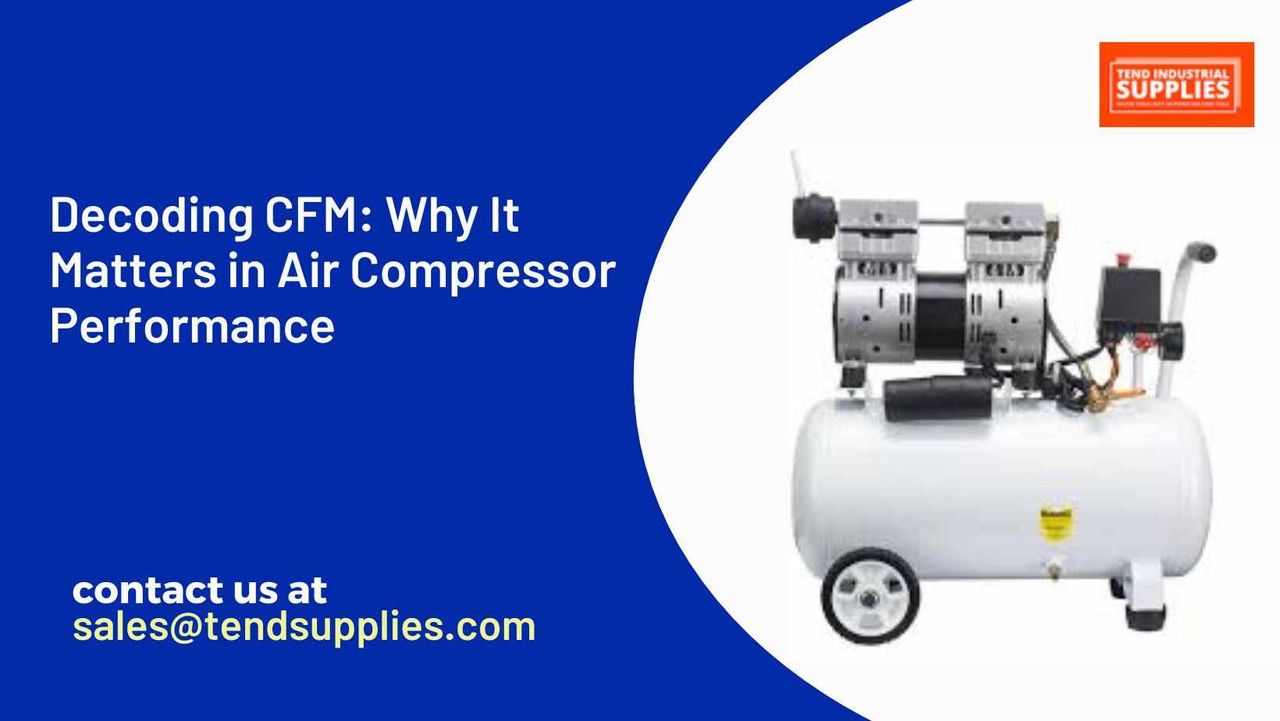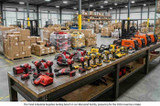Decoding CFM: Why It Matters in Air Compressor Performance
Understanding the technical specifications is crucial for making an informed decision when dealing with air compressors. Among these specifications, CFM (Cubic Feet per Minute) is one of the most important yet often misunderstood metrics. In this comprehensive guide, we'll decode CFM, explore its significance in air compressor performance, and help you make the best choice for your needs.
Key Takeaway: CFM is a crucial factor in air compressor performance. Understanding your CFM requirements and how they relate to your specific needs will lead to more informed decisions and better results in your projects.
What is CFM?
CFM, or Cubic Feet per Minute, measures air flow. In the context of air compressors, it represents the volume of air that a compressor can deliver in one minute at a specific pressure, usually measured in PSI (Pounds per Square Inch).
Key Points About CFM:
- It's a measure of volume, not pressure.
- CFM ratings are typically given at specific PSI levels.
- Higher CFM means more air delivery, which generally translates to better performance.
Why CFM Matters in Air Compressor Performance
Understanding CFM is crucial because it directly impacts the compressor's ability to perform various tasks. Here's why CFM is so important:
1. Determines Tool Compatibility
Different air tools require different CFM rates to operate effectively. A compressor with insufficient CFM cannot power certain tools properly.
2. Affects Work Efficiency
Higher CFM allows forthe continuous operation of air tools without frequent stops, increasing productivity.
3. Influences Recovery Time
Compressors with higher CFM can replenish their air tanks faster, reducing downtime between tasks.
4. Impacts Multi-Tool Usage
If you plan to run multiple tools simultaneously, you'll need a compressor with a CFM rating that can handle the combined air requirements.
How to Interpret CFM Ratings
When looking at air compressor specifications, you'll often see CFM ratings presented in different ways:
1. CFM @ PSI
For example, "5 CFM @ 90 PSI" means the compressor can deliver 5 cubic feet of air per minute at 90 pounds per square inch of pressure.
2. SCFM (Standard Cubic Feet per Minute)
CFM is measured at standard temperature and pressure conditions (usually 68°F and 36% relative humidity at sea level).
3. Displacement CFM
This represents the theoretical maximum air output of the compressor pump, not accounting for losses. It's always higher than the actual delivered CFM.
4. Free Air Delivery
This is the amount of air the compressor delivers, accounting for all losses. It's the most realistic measure of a compressor's output.
Factors Affecting CFM
Several factors can influence a compressor's CFM output:
- Motor Power: Generally, more powerful motors can drive higher CFM rates.
- Pump Design: Efficient pump designs can increase CFM output.
- Operating Pressure: CFM typically decreases as operating pressure increases.
- Altitude: Higher altitudes can reduce CFM output due to lower air density.
- Temperature: Higher temperatures can affect compressor efficiency and CFM output.
Calculating CFM Requirements
To determine the CFM you need, follow these steps:
- List all the air tools you plan to use.
- Find the CFM requirements for each tool (usually listed in the tool's specifications).
- Identify the tool with the highest CFM requirement.
- Add about 30% to this number to account for future needs and inefficiencies.
For example:
- Impact Wrench: 5 CFM
- Paint Sprayer: 12 CFM
- Nail Gun: 2 CFM
Highest CFM requirement: 12 CFM (Paint Sprayer) Add 30%: 12 CFM x 1.3 = 15.6 CFM
In this case, you'd want a compressor that can deliver at least 15.6 CFM.
Common CFM Ranges and Their Applications
Understanding typical CFM ranges can help you choose the right compressor for your needs:
1-5 CFM
- Suitable for: Inflation, small nail guns, staple guns
- Typical compressor: Small portable units
5-10 CFM
- Suitable for: Most DIY and light professional tasks
- Tools: Medium-sized nail guns, impact wrenches, small sanders
- Typical compressor: Pancake or hot dog style compressors
10-15 CFM
- Suitable for: More demanding DIY and professional tasks
- Tools: Larger sanders, grinders, spray guns
- Typical compressor: Belt-driven or two-stage compressors
15+ CFM
- Suitable for: Heavy-duty professional and industrial applications
- Tools: Multiple tools simultaneously, large spray guns, sandblasting equipment
- Typical compressor: Large stationary units, often two-stage
The Relationship Between CFM and PSI
CFM and PSI are inversely related. As pressure (PSI) increases, the volume of air (CFM) that can be delivered decreases. This relationship is crucial to understand because:
- Tools require both adequate CFM and PSI to function properly.
- Compressors have a maximum PSI rating at which they can deliver their rated CFM.
- Operating at lower pressures can increase available CFM.
Related Articles
Air Tool Efficiency: PSI vs. CFM Explained
Comparing Air Compressors: Which One Suits Your .Workshop?.
CFM and Tank Size: What's the Connection?
While CFM is determined by the compressor's pump and motor, tank size can affect how you experience CFM in practice:
- Larger tanks act as reservoirs, allowing for short bursts of high CFM usage even if the pump's continuous output is lower.
- Smaller tanks require more frequent compressor cycling, which can be an issue for high-CFM applications.
- For continuous high-CFM applications, tank size is less important than the actual CFM output of the compressor.
Innovations in CFM Technology
As air compressor technology advances, we're seeing innovations that impact CFM performance:
- Variable Speed Drives: These adjust motor speed to match CFM demand, increasing efficiency.
- Advanced Cooling Systems: Better cooling allows for higher sustained CFM output.
- Multi-Stage Compression: This technology can provide higher CFM at higher pressures more efficiently.
- Smart Compressors: These units can adjust CFM output based on real-time demand, optimizing performance and energy use.
CFM and Energy Efficiency
Understanding CFM can also help you choose a more energy-efficient compressor:
- Matching CFM to your needs prevents energy waste from oversized compressors.
- Variable speed compressors can adjust CFM output to match demand, saving energy.
- Higher CFM at lower pressures is generally more energy-efficient than lower CFM at higher pressures.
Common Mistakes When Considering CFM
Avoid these common pitfalls when evaluating compressor CFM:
- Ignoring CFM Altogether: Focusing only on PSI or tank size can lead to inadequate performance.
- Underestimating Needs: Not accounting for future tools or simultaneous use can result in insufficient CFM.
- Misinterpreting Ratings: Confusing displacement CFM with actual delivered CFM can lead to disappointment in real-world performance.
- Overlooking Duty Cycle: A compressor might have high CFM but a short duty cycle, limiting continuous use.
Maintenance Tips for Optimal CFM Performance
To ensure your compressor maintains its CFM performance over time:
- Regularly clean or replace air filters to maintain airflow.
- Keep the compressor cool to prevent CFM loss due to overheating.
- Check and tighten belts on belt-driven compressors to prevent slippage.
- Drain moisture from the tank regularly to prevent corrosion and maintain efficiency.
- Follow the manufacturer's maintenance schedule for oil changes and part replacements.
Conclusion: Making CFM Work for You
Understanding CFM is key to choosing and using an air compressor effectively. By matching your CFM needs to the right compressor, you ensure that you have the power and performance required for your tasks, whether you're a DIY enthusiast or a professional contractor.
Remember:
- CFM is a measure of air volume delivery.
- Higher CFM generally means better performance and versatility.
- CFM needs vary based on the tools and applications you use.
- CFM, PSI, and tank size all determine a compressor's overall performance.
Ready to find the perfect air compressor with the right CFM for your needs? Visit Tend Industrial Supplies at tendsupplies.com or contact our expert team at sales@tendsupplies.com. We'll help you decode the specs and find the ideal compressor to confidently power your projects.









